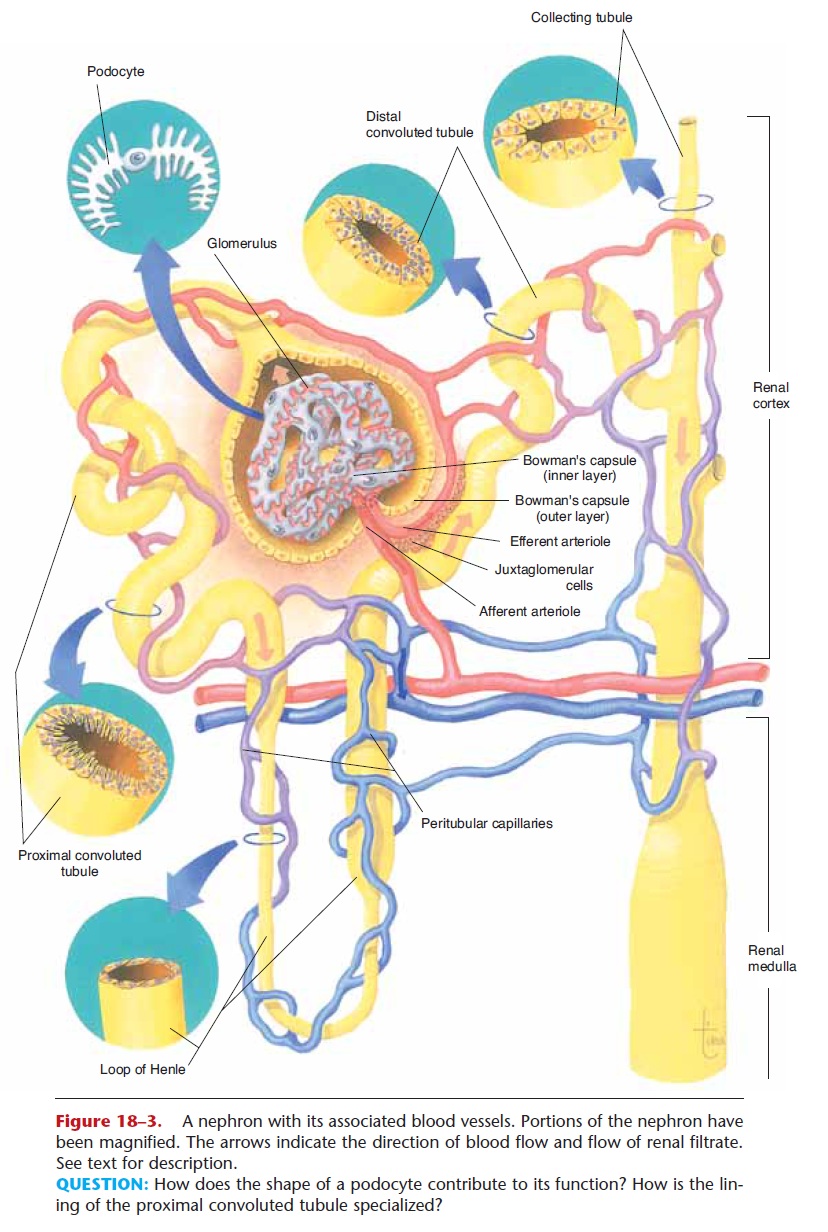Chapter: Essentials of Anatomy and Physiology: The Urinary System
Nephron - Anatomy and Physiology

THE NEPHRON
The nephron is the structural and functional unit of the kidney. Each kidney contains approximately 1 million nephrons. It is in the nephrons, with their associ-ated blood vessels, that urine is formed. Each nephron has two major portions: a renal corpuscle and a renal tubule. Each of these major parts has further subdivi-sions, which are shown with their blood vessels in Fig. 18–3.

QUESTION: How does the shape of a podocyte contribute to its function? How is the lin-ing of the proximal convoluted tubule specialized?
Renal Corpuscle
A renal corpuscle consists of a glomerulus surroun-ded by a Bowman’s capsule. The glomerulus is a cap-illary network that arises from an afferent arteriole and empties into an efferent arteriole. The diameter
Bowman’s capsule (or glomerular capsule) is the expanded end of a renal tubule; it encloses the glomerulus. The inner layer of Bowman’s capsule is made of podocytes; the name means “foot cells,” and the “feet” of the podocytes are on the surface of the glomerular capillaries. The arrangement of podocytes creates pores, spaces between adjacent “feet,” which make this layer very permeable. The outer layer of Bowman’s capsule has no pores and is not permeable. The space between the inner and outer layers of Bowman’s capsule contains renal filtrate, the fluid that is formed from the blood in the glomerulus and will eventually become urine.
Renal Tubule
The renal tubule continues from Bowman’s capsule and consists of the following parts: proximal convo-luted tubule (in the renal cortex), loop of Henle (or loop of the nephron, in the renal medulla), and distal convoluted tubule (in the renal cortex). The distalconvoluted tubules from several nephrons empty into a collecting tubule. Several collecting tubules then unite to form a papillary duct that empties urine into a calyx of the renal pelvis.
Cross-sections of the parts of the renal tubule are shown in Fig. 18–3. Notice how thin the walls of the tubule are, and also the microvilli in the proximal con-voluted tubule. These anatomic characteristics provide for efficient exchanges of materials, as you will see.
All parts of the renal tubule are surrounded by peritubular capillaries, which arise from the efferent arteriole. The peritubular capillaries will receive the materials reabsorbed by the renal tubules; this is described in the section on urine formation.


Figure 18–2. (A) Frontal section of the right kidney showing internal structure and blood vessels. (B) The magnified section of the kidney shows several nephrons. (C) Vascular cast of a kidney in lateral view. Red plastic fills the blood vessels. (D) Vascular cast in medial view. Blood vessels have been removed; yellow plastic fills the renal pelvis. (Photographs C and D by Dan Kaufman.)
QUESTION: Which main parts of a nephron are found in the renal cortex? Which areas of a kidney have many blood vessels?
Related Topics